2023 HYUNDAI SANTA CRUZ Towing
[x] Cancel search: TowingPage 482 of 598
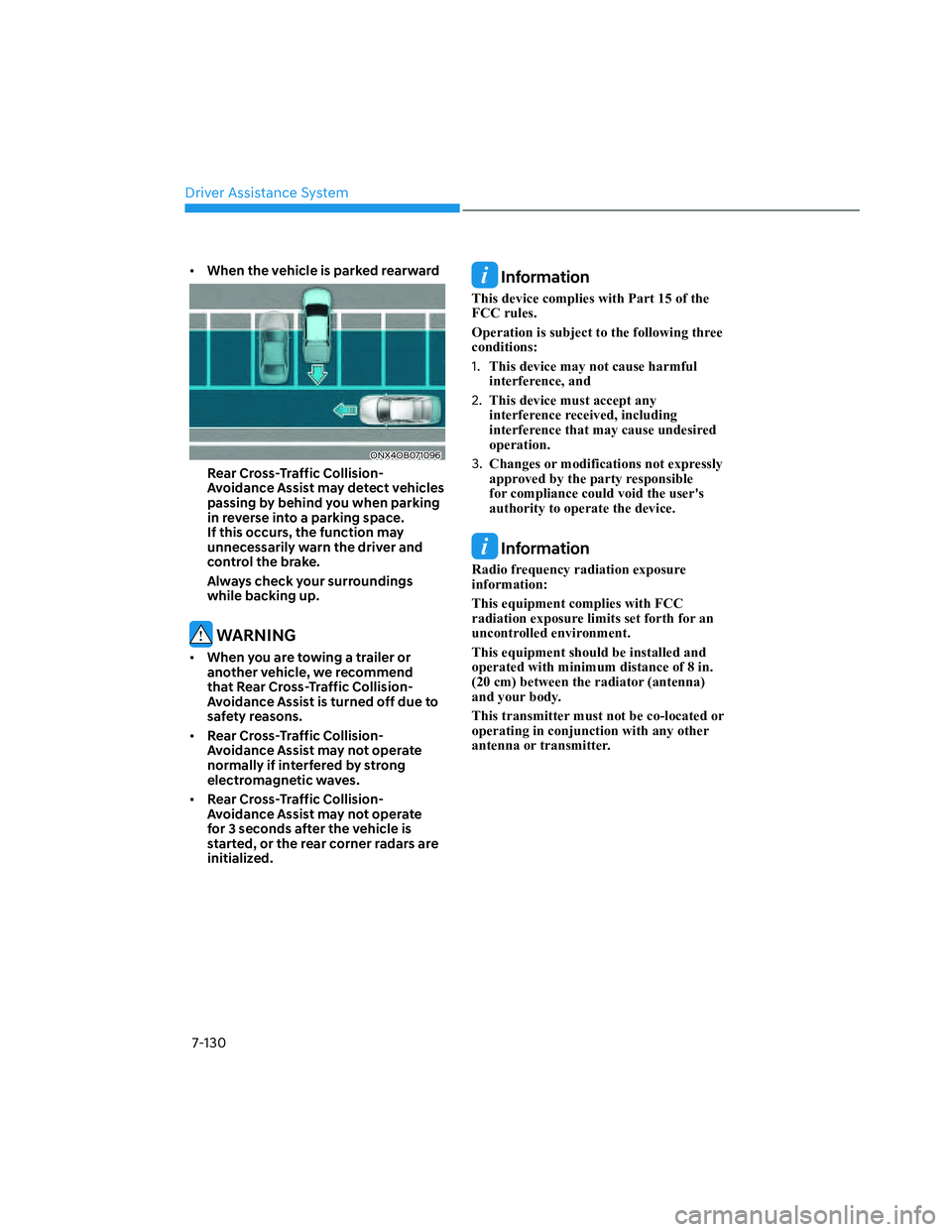
Driver Assistance System
7-130
• When the vehicle is parked rearward
ONX4OB071096ONX4OB071096
Rear Cross-Traffic Collision-
Avoidance Assist may detect vehicles
passing by behind you when parking
in reverse into a parking space.
If this occurs, the function may
unnecessarily warn the driver and
control the brake.
Always check your surroundings
while backing up.
WARNING
• When you are towing a trailer or
another vehicle, we recommend
that Rear Cross-Traffic Collision-
Avoidance Assist is turned off due to
safety reasons.
• Rear Cross-Traffic Collision-
Avoidance Assist may not operate
normally if interfered by strong
electromagnetic waves.
• Rear Cross-Traffic Collision-
Avoidance Assist may not operate
for 3 seconds after the vehicle is
started, or the rear corner radars are
initialized.
Information
This device complies with Part 15 of the
FCC rules.
Operation is subject to the following three
conditions:
1. This device may not cause harmful
interference, and
2. This device must accept any
interference received, including
interference that may cause undesired
operation.
3. Changes or modifications not expressly
approved by the party responsible
for compliance could void the user's
authority to operate the device.
Information
Radio frequency radiation exposure
information:
This equipment complies with FCC
radiation exposure limits set forth for an
uncontrolled environment.
This equipment should be installed and
operated with minimum distance of 8 in.
(20 cm) between the radiator (antenna)
and your body.
This transmitter must not be co-located or
operating in conjunction with any other
antenna or transmitter.
Page 485 of 598
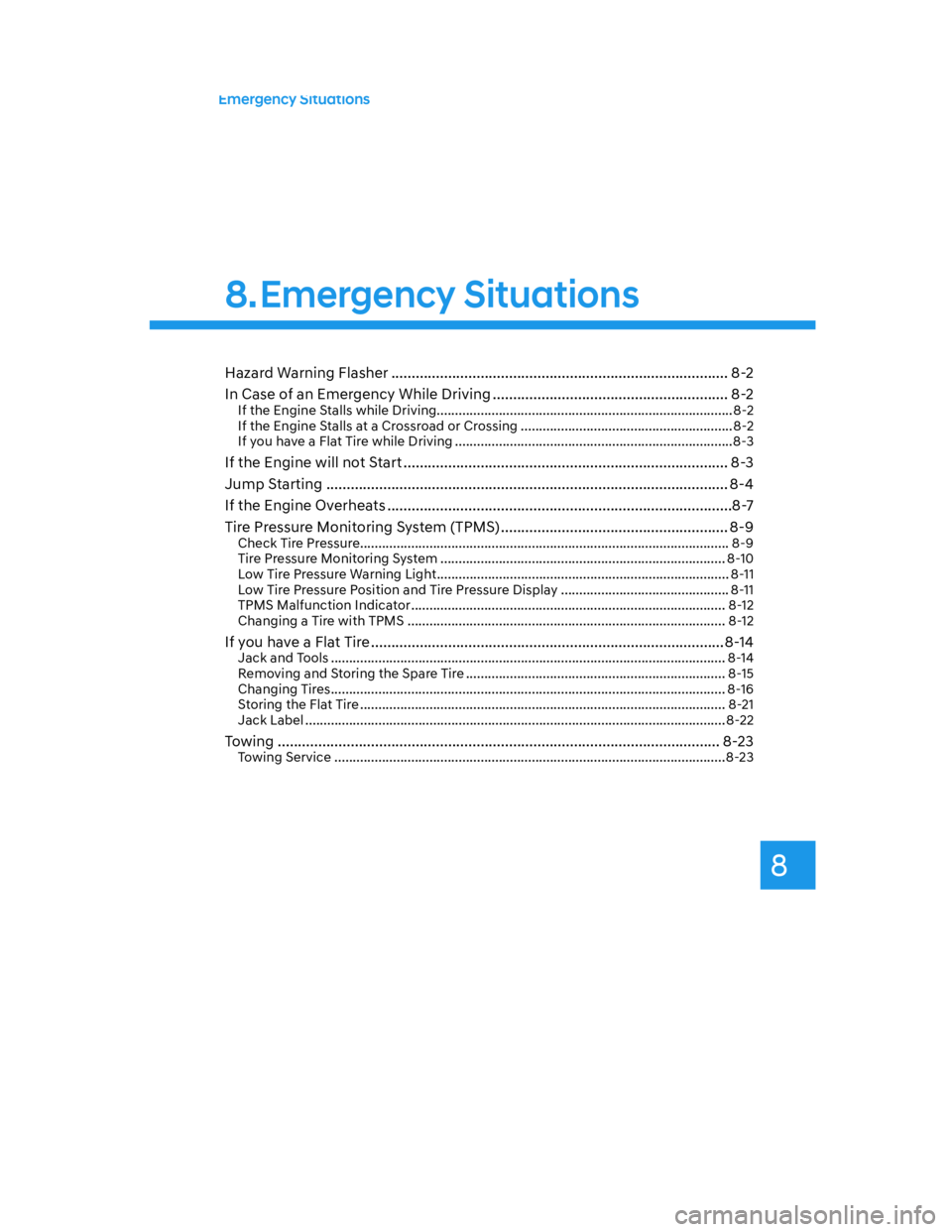
8
Emergency Situations
Hazard Warning Flasher ................................................................................... 8-2
In Case of an Emergency While Driving .......................................................... 8-2
If the Engine Stalls while Driving................................................................................. 8-2
If the Engine Stalls at a Crossroad or Crossing .......................................................... 8-2
If you have a Flat Tire while Driving ............................................................................8-3
If the Engine will not Start ................................................................................ 8-3
Jump Starting ................................................................................................... 8-4
If the Engine Overheats .....................................................................................8-7
Tire Pressure Monitoring System (TPMS) ........................................................ 8-9
Check Tire Pressure ..................................................................................................... 8-9
Tire Pressure Monitoring System .............................................................................. 8-10
Low Tire Pressure Warning Light ................................................................................ 8-11
Low Tire Pressure Position and Tire Pressure Display .............................................. 8-11
TPMS Malfunction Indicator ...................................................................................... 8-12
Changing a Tire with TPMS ....................................................................................... 8-12
If you have a Flat Tire .......................................................................................8-14
Jack and Tools ............................................................................................................ 8-14
Removing and Storing the Spare Tire ....................................................................... 8-15
Changing Tires ............................................................................................................ 8-16
Storing the Flat Tire .................................................................................................... 8-21
Jack Label ................................................................................................................... 8-22
Towing ............................................................................................................. 8-23
Towing Service ........................................................................................................... 8-23
8. Emergency Situations
Page 488 of 598

Emergency Situations
8-4
Jump starting can be dangerous if done
incorrectly. Follow the jump starting
procedure in this section to avoid serious
injury or damage to your vehicle. If in
doubt about how to properly jump start
your vehicle, we strongly recommend
that you have a service technician or
towing service do it for you.
WARNING
To prevent SERIOUS INJURY or DEATH
to you or bystanders, always follow
these precautions when working near
or handling the battery:
Always read and follow
instructions carefully when
handling a battery.
Wear eye protection designed
to protect the eyes from acid
splashes.
Keep all flames, sparks, or
smoking materials away from
the battery.
Hydrogen is always present
in battery cells, is highly
combustible, and may explode
if ignited.
Keep batteries out of reach of
children.
Batteries contain sulfuric acid
which is highly corrosive. Do
not allow acid to contact your
eyes, skin or clothing.If acid gets into your eyes, flush your
eyes with clean water for at least 15
minutes and get immediate medical
attention. If acid gets on your skin,
thoroughly wash the area. If you feel
pain or a burning sensation, get medical
attention immediately.
• When lifting a plastic-cased battery,
excessive pressure on the case may
cause battery acid to leak. Lift with a
battery carrier or with your hands on
opposite corners.
• Do not attempt to jump start your
vehicle if your battery is frozen.
• NEVER attempt to recharge the
battery when the vehicle’s battery
cables are connected to the battery.
• The electrical ignition system works
with high voltage.
NEVER touch these componentswith
the engine running or when
theEngine Start/Stop button is in
the ONposition or when the ignition
switch is in the ON position.
JUMP STARTING
Page 500 of 598
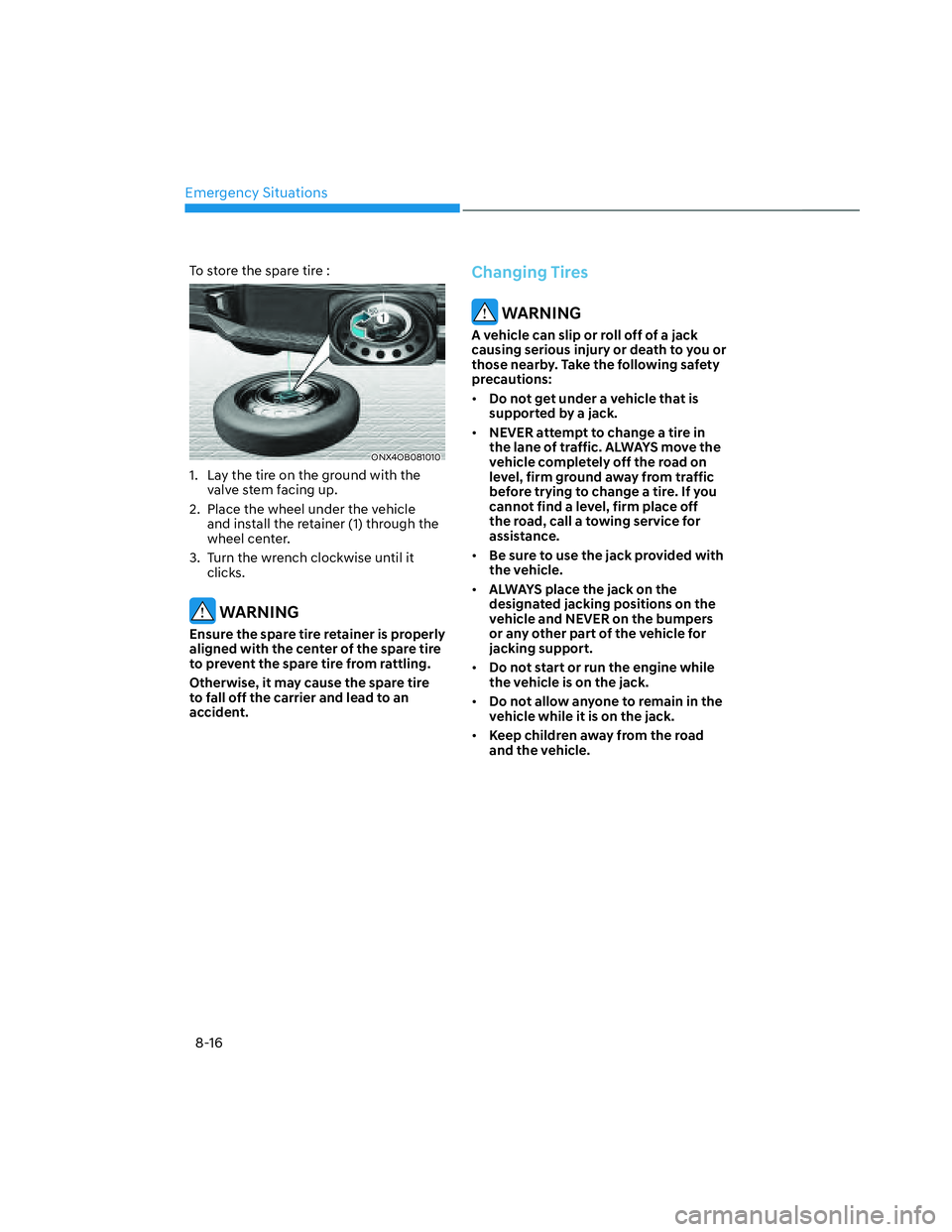
Emergency Situations
8-16
To store the spare tire :
ONX4OB081010ONX4OB081010
1. Lay the tire on the ground with the
valve stem facing up.
2. Place the wheel under the vehicle
and install the retainer (1) through the
wheel center.
3. Turn the wrench clockwise until it
clicks.
WARNING
Ensure the spare tire retainer is properly
aligned with the center of the spare tire
to prevent the spare tire from rattling.
Otherwise, it may cause the spare tire
to fall off the carrier and lead to an
accident.
Changing Tires
WARNING
A vehicle can slip or roll off of a jack
causing serious injury or death to you or
those nearby. Take the following safety
precautions:
• Do not get under a vehicle that is
supported by a jack.
• NEVER attempt to change a tire in
the lane of traffic. ALWAYS move the
vehicle completely off the road on
level, firm ground away from traffic
before trying to change a tire. If you
cannot find a level, firm place off
the road, call a towing service for
assistance.
• Be sure to use the jack provided with
the vehicle.
• ALWAYS place the jack on the
designated jacking positions on the
vehicle and NEVER on the bumpers
or any other part of the vehicle for
jacking support.
• Do not start or run the engine while
the vehicle is on the jack.
• Do not allow anyone to remain in the
vehicle while it is on the jack.
• Keep children away from the road
and the vehicle.
Page 507 of 598
![HYUNDAI SANTA CRUZ 2023 Owners Manual 08
8-23
TOWING
Towing Service
A
ONX4OB081016ONX4OB081016[A] : Dollies
If emergency towing is necessary,
we recommend having it done by
an authorized HYUNDAI dealer or a
commercial tow-truck service HYUNDAI SANTA CRUZ 2023 Owners Manual 08
8-23
TOWING
Towing Service
A
ONX4OB081016ONX4OB081016[A] : Dollies
If emergency towing is necessary,
we recommend having it done by
an authorized HYUNDAI dealer or a
commercial tow-truck service](/manual-img/35/56179/w960_56179-506.png)
08
8-23
TOWING
Towing Service
A
ONX4OB081016ONX4OB081016[A] : Dollies
If emergency towing is necessary,
we recommend having it done by
an authorized HYUNDAI dealer or a
commercial tow-truck service.
Proper lifting and towing procedures
are necessary to prevent damage to
the vehicle. The use of wheel dollies or
flatbed is recommended.
For FWD vehicles, it is acceptable to tow
the vehicle using a tow truck as long as
the front wheels (which are the drive
wheels) are off the ground. The rear
wheels can be on the ground without the
use of dollies.
For AWD vehicles, all wheels must be off
the ground. Therefore, a flat bed trailer is
recommended.
If any of the loaded wheels or suspension
components are damaged or the vehicle
is being towed with the rear wheels on
the ground, use a towing dolly under the
rear wheels.
When being towed by a commercial tow
truck and wheel dollies are not used,
the front of the vehicle should always be
lifted, not the rear.
For AWD vehicles, it must be towed
with a wheel lift and dollies or flatbed
equipment with all the wheels off the
ground.
NOTICE
Do not lift the vehicle by the tow fitting
or body and chassis parts. Otherwise
the vehicle may be damaged.
CAUTION
• Do not tow the vehicle with the front
wheels on the ground as this may
cause damage to the vehicle.
ONX4OB081017ONX4OB081017
• Do not tow with sling-type
equipment. Use wheel lift or flatbed
equipment.
ONX4OB081018ONX4OB081018
Page 508 of 598
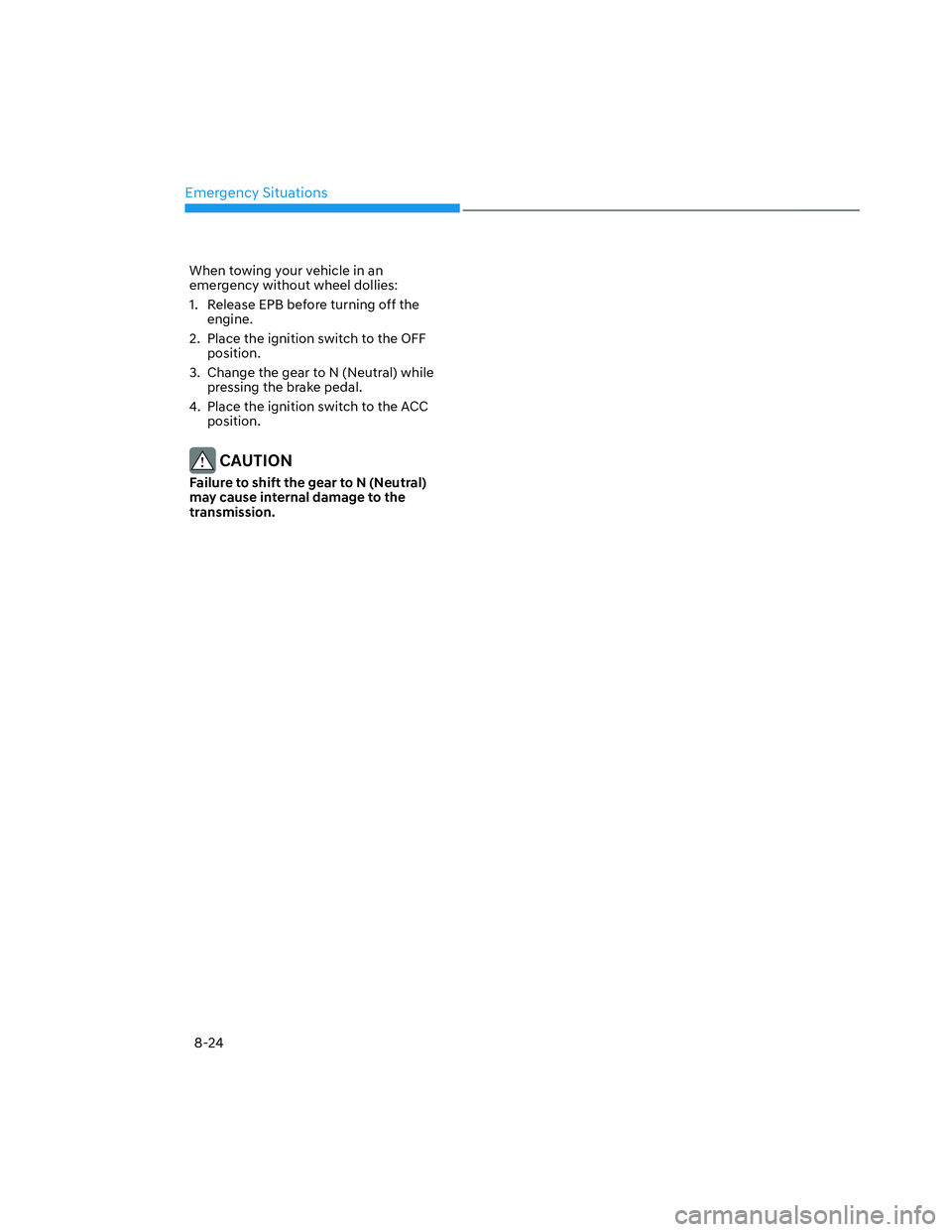
Emergency Situations
8-24
When towing your vehicle in an
emergency without wheel dollies:
1. Release EPB before turning off the
engine.
2. Place the ignition switch to the OFF
position.
3. Change the gear to N (Neutral) while
pressing the brake pedal.
4. Place the ignition switch to the ACC
position.
CAUTION
Failure to shift the gear to N (Neutral)
may cause internal damage to the
transmission.
Page 515 of 598

09
9-7
Follow Normal Maintenance Schedule if the vehicle is usually operated where none of
the following conditions apply. If any of the following conditions apply, you must follow
the Maintenance Under Severe Usage Conditions.
• Repeated driving short distance of less than 5 miles (8 km) in normal temperature or
less than 10 miles (16 km) in freezing temperature
• Extensive engine idling or low speed driving for long distances
• Driving on rough, dusty, muddy, unpaved, graveled or salt-spread roads
• Driving in areas using salt or other corrosive materials or in very cold weather
• Driving in heavy dust conditions
• Driving in heavy traffic area
• Driving on uphill, downhill, or mountain road repeatedly
• Towing a trailer or using a camper, or driving with loads on the roof
• Driving as a patrol car, taxi, other commercial use of vehicle towing
• Frequently driving under high speed or rapid acceleration/deceleration
• Frequently driving in stop-and-go condition
• Engine oil usage which is not recommended (Mineral type, Semi-synthetic, Lower
grade spec, etc.)
If your vehicle is operated under the above conditions, you should inspect, replace
or refill more frequently than the following Normal Maintenance Schedule. After the
periods or distance shown in the chart, continue to follow the prescribed maintenance
intervals.
NOTICE
After 10 years or 100,000 miles, we recommend to use severe maintenance
schedule.
Information
• As it is normal for engine oil to be consumed during driving, the engine oil level should
be checked on regular basis.
• The engine oil change interval for normal operating conditions is based on the use of
the recommended engine specification. If the recommended engine oil specification
is not used, then replace the engine oil according to the maintenance schedule under
severe operating conditions.
SCHEDULED MAINTENANCE SERVICES
Page 521 of 598
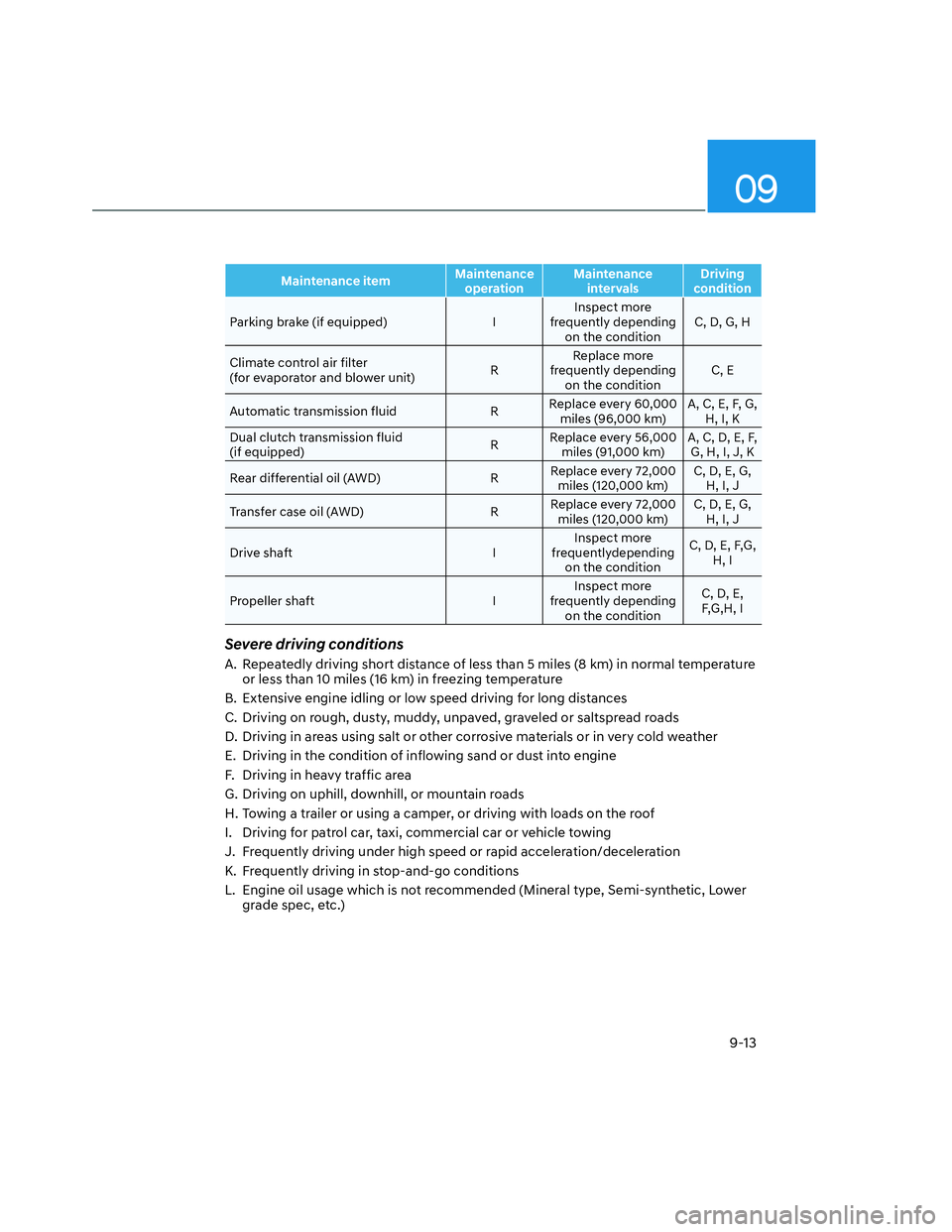
09
9-13
Maintenance itemMaintenance
operationMaintenance
intervalsDriving
condition
Parking brake (if equipped) IInspect more
frequently depending
on the conditionC, D, G, H
Climate control air filter
(for evaporator and blower unit)RReplace more
frequently depending
on the conditionC, E
Automatic transmission fluid RReplace every 60,000
miles (96,000 km)A, C, E, F, G,
H, I, K
Dual clutch transmission fluid
(if equipped)RReplace every 56,000
miles (91,000 km)A, C, D, E, F,
G, H, I, J, K
Rear differential oil (AWD) RReplace every 72,000
miles (120,000 km)C, D, E, G,
H, I, J
Transfer case oil (AWD) RReplace every 72,000
miles (120,000 km)C, D, E, G,
H, I, J
Drive shaft IInspect more
frequentlydepending
on the conditionC, D, E, F,G,
H, I
Propeller shaft IInspect more
frequently depending
on the conditionC, D, E,
F,G,H, I
Severe driving conditions
A. Repeatedly driving short distance of less than 5 miles (8 km) in normal temperature
or less than 10 miles (16 km) in freezing temperature
B. Extensive engine idling or low speed driving for long distances
C. Driving on rough, dusty, muddy, unpaved, graveled or saltspread roads
D. Driving in areas using salt or other corrosive materials or in very cold weather
E. Driving in the condition of inflowing sand or dust into engine
F. Driving in heavy traffic area
G. Driving on uphill, downhill, or mountain roads
H. Towing a trailer or using a camper, or driving with loads on the roof
I. Driving for patrol car, taxi, commercial car or vehicle towing
J. Frequently driving under high speed or rapid acceleration/deceleration
K. Frequently driving in stop-and-go conditions
L. Engine oil usage which is not recommended (Mineral type, Semi-synthetic, Lower
grade spec, etc.)